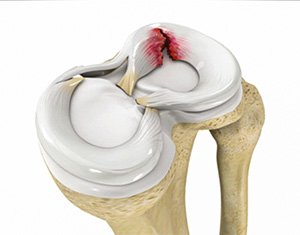Meniscal Tear
Meniscal tears are a common injury of the knee often treated with arthroscopic or “Keyhole” surgery.
However, in patients over 50 years old, arthroscopic surgery often does poorly compared to younger patients, particularly when the knee has some arthritis. Keyhole surgery in older patients may often make the pain worse and may often lead to further, more significant surgery such as knee replacement.
We suggest trying non-operative management before contemplating surgery.
Normal menisci
Meniscal tear
Management options
Weight loss
Increased loading of the knee through excessive weight is a significant factor in knee disease. Weight loss is always beneficial in these situations but can be difficult due to restricted physical activity. It is important to consider dietary impact as this is the main factor in successful weight loss, as well as exercise.
Strengthening
Increasing the stability of the knee through strengthening is also effective in reducing the pain and the need for surgery. This is achieved through an exercise program, focusing on low bend, low impact activity such as a stationary exercise bike (with the seat high up) and hydrotherapy, walking in the pool, swimming and physiotherapy.
Torn cartilage
Medication
Use simple analgesia such as paracetamol and short courses of anti-inflammatories, being careful about side effects such as stomach irritation and kidney problems.
Injections
Steroid injections can settle inflammation rapidly and may be enough to return to normal function and start their rehabilitation. Synthetic joint lubricants (eg. Synvisc one) may also be an option, especially in the degenerative knee.
The place of surgery
About 50% of patients will get better following the non-operative plan above. If this conservative treatment fails to resolve your symptoms within 6 weeks or so, then surgical options might be considered.
If you have significant mechanical symptoms (catching, locking), then arthroscopic surgery may be warranted, but this may lead to further surgery including joint replacement.
